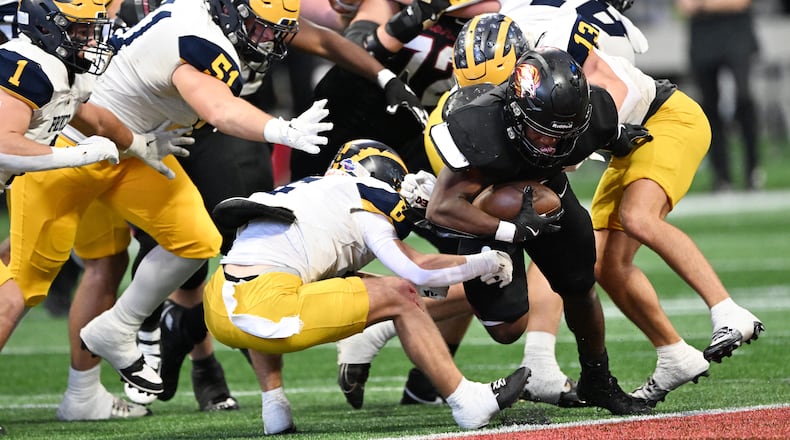Private schools are standing by the GHSA’s proposed competitive-balance reclassification model as their best hope of freeing themselves from the GHSA’s Class 3A-A private playoff division, which they loathe. But if competitive balance doesn’t win the day, they would prefer the 2022-24 model that allowed them to compete with public schools in state competitions.
Mount Vernon athletic director Brad Dehem last week submitted a proposal that puts the old model back on the table ahead of Sunday’s reclassification committee meeting in Macon. The new reclass cycle begins in 2026.
“In all honesty, it will be even tougher to pass this through than the competitive-balance model, but I wanted to raise some awareness and give more reasons to help support the competitive-balance model,” Dehem told the AJC. “My objective is still to get this (competitive balance) passed. But by getting some of the information to the table, we can hopefully all start to agree that the environment is changing around interscholastic athletics and come to the table together with a mutual understanding of where we need to go as an organization.”
Dehem acknowledges that private schools have competitive advantages, namely selective admission and the lack of district boundaries to limit their pool of students. But Dehem and others argue that public schools also have advantages and that it is wrong to single out private schools for theirs.
“Undoubtedly, the ability of private schools to attract students from outside their attendance zone is an advantage and a variable that can lead to athletic success,” said Woodward Academy athletic director Jose Fernandez, a reclass committee member. “However, many public schools are also doing this now as well, and I think it is time for us as a state organization to look at the many other variables that lead to athletic success instead of focusing on just one variable. ... Private schools simply want to be treated equitably compared to public schools.”
The competitive-balance model would classify the GHSA’s 456 schools based on their sports success. Private schools like the model in part because it applies the same criteria to public and private schools for moving them up or down in class and would allow them to face each other in state playoffs.
Currently, only the eight private schools in classes 5A and 4A are competing against public schools in all state events.
Public schools, which make up about 90% of the GHSA’s membership, forced smaller private schools into a private-only playoff division starting last fall after private schools won 73 of the 152 state championships contested in Class 3A and below.
In his proposal, Dehem pointed out competitive advantages that schools might possess, such as high-dollar booster clubs, higher salaries for coaches, SPLOST potential for updating facilities and easier access to private coaching and year-round club teams.
“The ability to correctly regulate a school’s classification ... based on only one factor or any number of multiple factors, stated or unstated, is untenable,” Dehem wrote in his proposal. “We should be less focused on restricting or penalizing a school primarily based on one factor. ... We should be more focused on the actual success or lack of success as the reason for adjustment for a school to be in another classification.”
It is a gamble for private schools to pin their hopes on competitive balance to set them free. A straw poll taken in February showed that 11 of 18 reclass committee members opposed the model. Two were undecided.
Three of the five supporters were the lone private-school representatives — Fernandez, Athens Academy’s Kevin Petroski and Blessed Trinity’s Ricky Turner.
Petroski said that private schools have concerns, too. Competitive balance as proposed would move entire schools up, meaning that one or two weaker teams in a successful sports program might unfairly suffer. That could be especially troublesome for football teams, which could be risking injury playing too high in class. Petroski asked during last month’s committee meeting if the model could apply to individual sports teams and not schools.
Petroski remains a competitive-balance proponent, and he agrees with Dehem that it is proper to consider all competitive advantages.
“The competitive balance model has been the only proposal presented that demonstrates a willingness to classify schools based on success and, in some cases more importantly, a lack of success,” Petroski said. “Some people have asked the question, ‘What defines dominance?’ Apparently the reclass committee has defined it for the past 20 years by continuing to find ways to segregate private member schools from the rest of the membership, which begs the question, ‘Why are we only doing this to private member schools when it’s obvious there are public schools, city schools, charter schools, et cetera, that have demonstrated a certain level of dominance?‘“
No reclass decision is needed until October, but some believe that the reclass committee needs to move quickly to settle on the exact tenets of competitive balance so it has enough time to convert skeptics.
“I feel like we have had two years to work on a solution to reclassification, and we should be further along at this point,” Blessed Trinity’s Turner said. “There has been more work and time put into the competitive balance model than any other models I have seen in my 25 years as an AD. The competitive balance model was presented several years ago and has been tweaked several times, but not much has been finalized by the reclass committee. I feel like we need to finalize the competitive balance model so it can be presented to the executive committee.”
If that happens, Turner believes competitive balance has a good chance of passing. The GHSA’s office has endorsed the model, but it ultimately must get approval from the 68-member executive committee. That committee convenes Monday but is not expected to make any reclass decisions.
Private school athletic directors point out that competitive balance wasn’t their idea. The designers are public-school athletic directors Adam Lindsey of Gainesville and Jason Holcombe of Gwinnett County.
But private schools see competitive balance as a liberator that treats all schools the same. They hope public schools can see their point of view.
“Depending upon some of the results of sports this year, my school (Mount Vernon in Atlanta) is projected to possibly be one of the schools that would move up a classification,” Dehem said. “That would be a good reason not to want this competitive-balance model to pass. Self-interest has been a determinant in the past on classification votes from the full executive committee. I look forward to the leadership provided by the reclassification committee chairman Curt Miller and GHSA president Jim Finch. I know that their schools (Oconee County and Mary Persons, respectively) are possibly in a similar situation as mine. But we have to look beyond our own self-interests to find what is best for our entire organization.”
About the Author
Keep Reading
The Latest
Featured



